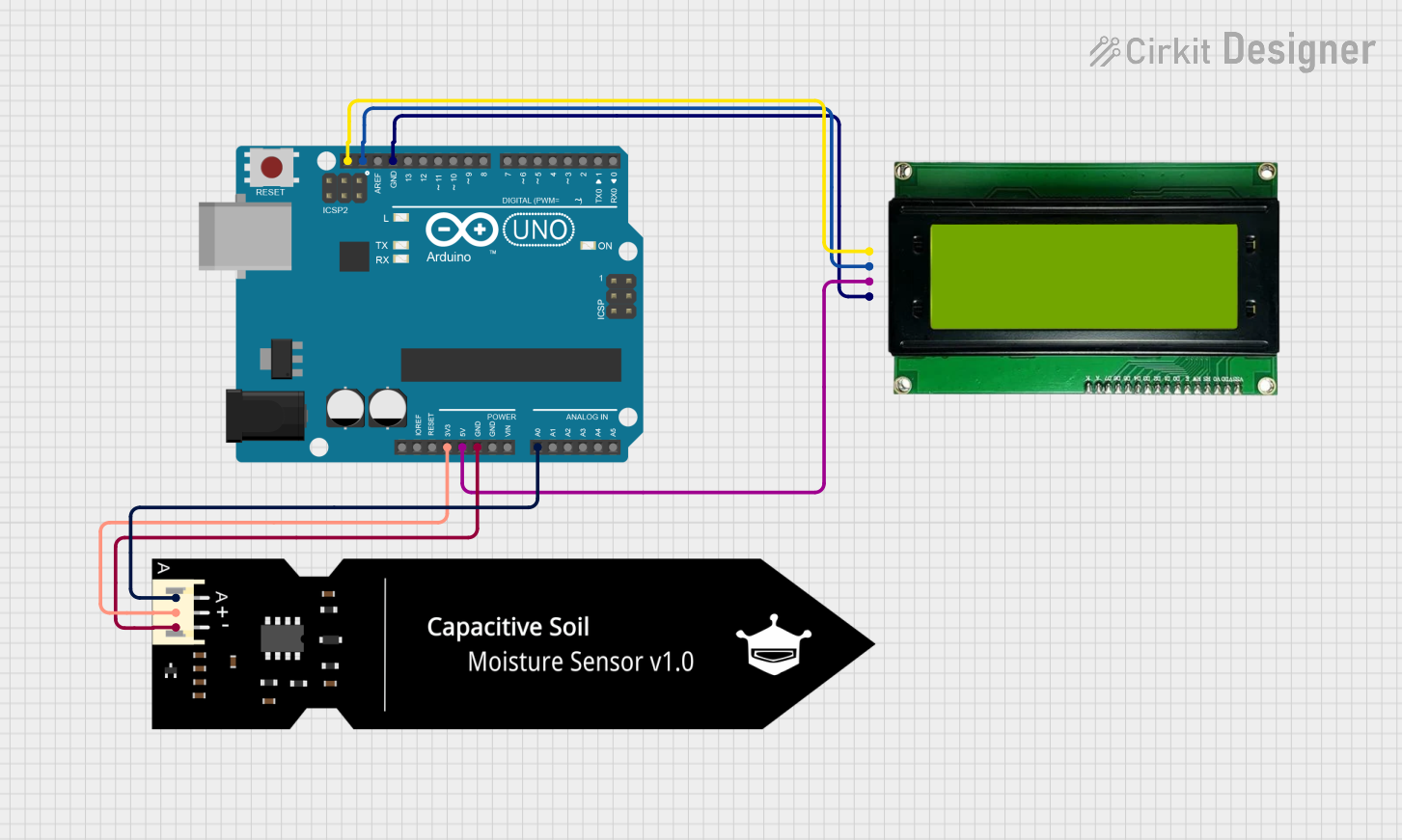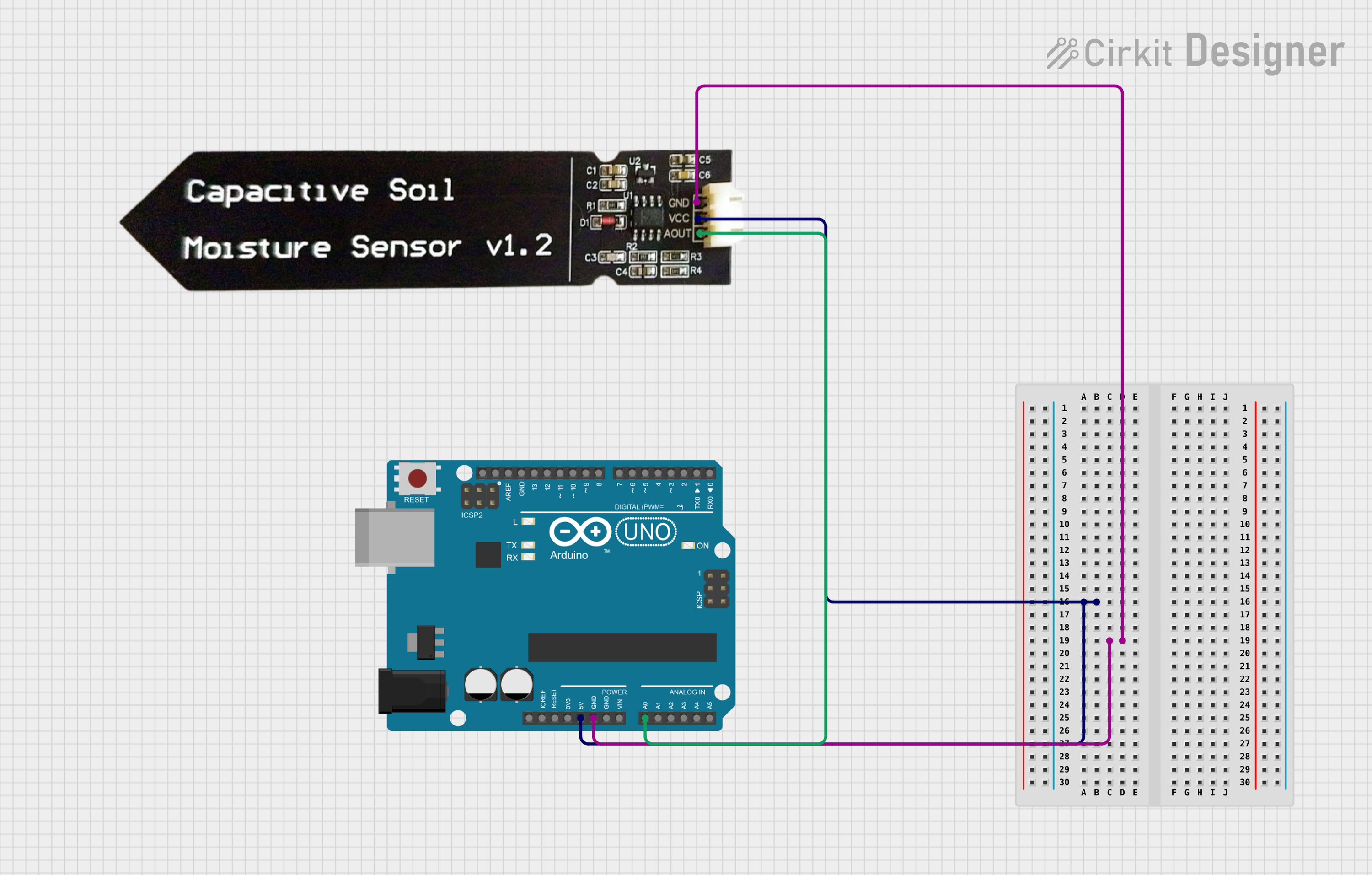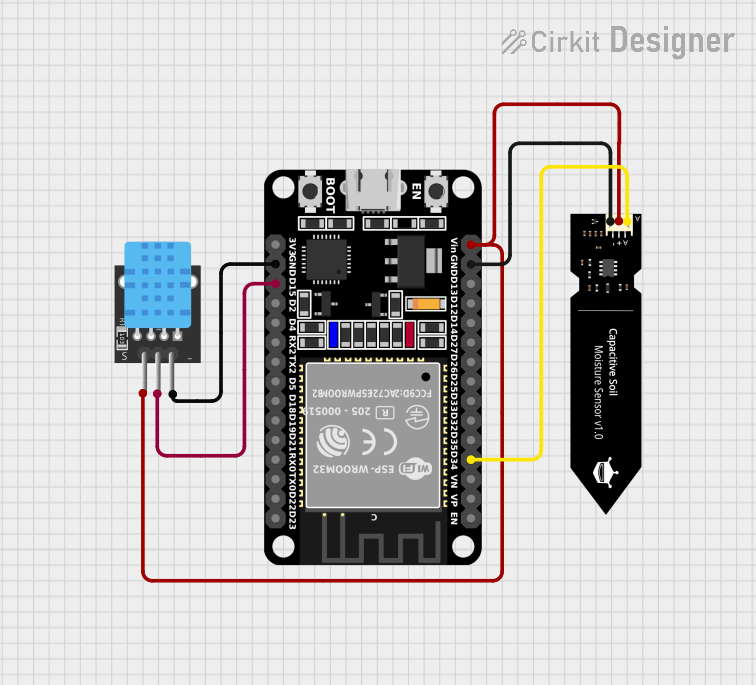
How to Use DFRobot Capacitive Soil Moisture Sensor (V1.0): Examples, Pinouts, and Specs

 Design with DFRobot Capacitive Soil Moisture Sensor (V1.0) in Cirkit Designer
Design with DFRobot Capacitive Soil Moisture Sensor (V1.0) in Cirkit DesignerIntroduction
The DFRobot Capacitive Soil Moisture Sensor (V1.0) is a reliable and durable sensor designed to measure the volumetric water content in soil. Unlike traditional resistive sensors, this sensor uses capacitive sensing technology, which eliminates the risk of corrosion and ensures long-term stability. It is ideal for applications such as automated irrigation systems, agricultural monitoring, and gardening projects.
Explore Projects Built with DFRobot Capacitive Soil Moisture Sensor (V1.0)

 Open Project in Cirkit Designer
Open Project in Cirkit Designer
 Open Project in Cirkit Designer
Open Project in Cirkit Designer
 Open Project in Cirkit Designer
Open Project in Cirkit Designer
 Open Project in Cirkit Designer
Open Project in Cirkit DesignerExplore Projects Built with DFRobot Capacitive Soil Moisture Sensor (V1.0)

 Open Project in Cirkit Designer
Open Project in Cirkit Designer
 Open Project in Cirkit Designer
Open Project in Cirkit Designer
 Open Project in Cirkit Designer
Open Project in Cirkit Designer
 Open Project in Cirkit Designer
Open Project in Cirkit DesignerCommon Applications and Use Cases
- Smart irrigation systems
- Soil moisture monitoring for agriculture
- Gardening and plant care automation
- Environmental monitoring projects
- Educational and DIY electronics projects
Technical Specifications
The DFRobot Capacitive Soil Moisture Sensor (V1.0) is designed for ease of use and compatibility with microcontrollers like Arduino. Below are its key technical details:
Key Technical Details
- Operating Voltage: 3.3V to 5.5V
- Output Voltage Range: 0V to 3V (analog signal)
- Current Consumption: < 20mA
- Interface: Analog
- Dimensions: 98mm x 23mm
- Weight: 15g
- Material: Corrosion-resistant PCB
Pin Configuration and Descriptions
The sensor has a simple 3-pin interface for easy connection to microcontrollers. The pinout is as follows:
| Pin | Name | Description |
|---|---|---|
| 1 | VCC | Power supply pin (3.3V to 5.5V) |
| 2 | GND | Ground connection |
| 3 | AOUT | Analog output pin that provides the moisture reading |
Usage Instructions
The DFRobot Capacitive Soil Moisture Sensor (V1.0) is straightforward to use in a circuit. Follow the steps below to integrate it into your project:
Connecting the Sensor
- Power the Sensor: Connect the
VCCpin to a 3.3V or 5V power source, depending on your microcontroller's operating voltage. - Ground the Sensor: Connect the
GNDpin to the ground of your microcontroller. - Read the Output: Connect the
AOUTpin to an analog input pin on your microcontroller to read the moisture level.
Important Considerations and Best Practices
- Calibration: The sensor's output voltage corresponds to soil moisture levels. You may need to calibrate the sensor for your specific soil type by taking readings in dry and saturated soil.
- Placement: Insert the sensor into the soil vertically, ensuring the sensing area is fully covered by soil for accurate readings.
- Avoid Submersion: Do not submerge the sensor in water, as it is designed for soil use only.
- Power Supply: Use a stable power source to avoid fluctuations in readings.
- Signal Filtering: If the readings are noisy, consider adding a capacitor between the
AOUTpin and ground to stabilize the signal.
Example Code for Arduino UNO
Below is an example of how to use the sensor with an Arduino UNO to read and display soil moisture levels:
// Define the analog pin connected to the sensor's AOUT pin
const int sensorPin = A0;
void setup() {
// Initialize serial communication for debugging
Serial.begin(9600);
}
void loop() {
// Read the analog value from the sensor
int sensorValue = analogRead(sensorPin);
// Map the sensor value to a percentage (0% to 100%)
int moisturePercent = map(sensorValue, 0, 1023, 0, 100);
// Print the moisture level to the Serial Monitor
Serial.print("Soil Moisture: ");
Serial.print(moisturePercent);
Serial.println("%");
// Wait for 1 second before taking the next reading
delay(1000);
}
Notes on the Code
- The
map()function is used to convert the raw analog reading (0-1023) into a percentage (0-100%). Adjust the mapping range if necessary based on your calibration. - Use the Serial Monitor in the Arduino IDE to view the moisture readings in real time.
Troubleshooting and FAQs
Common Issues and Solutions
No Output or Incorrect Readings
- Cause: Loose or incorrect wiring.
- Solution: Double-check the connections to ensure the
VCC,GND, andAOUTpins are properly connected.
Fluctuating or Noisy Readings
- Cause: Electrical noise or unstable power supply.
- Solution: Add a capacitor (e.g., 0.1µF) between the
AOUTpin and ground to filter noise.
Sensor Not Responding
- Cause: Sensor may be damaged or improperly powered.
- Solution: Verify the power supply voltage and ensure it is within the 3.3V to 5.5V range.
Inconsistent Readings in Different Soils
- Cause: Soil type and composition affect sensor output.
- Solution: Calibrate the sensor for the specific soil type by taking reference readings in dry and wet conditions.
FAQs
Q: Can this sensor be used outdoors?
A: Yes, but it should be protected from direct exposure to water and extreme weather conditions. Consider using a waterproof enclosure for outdoor projects.
Q: How do I interpret the sensor's output?
A: The sensor outputs an analog voltage that corresponds to soil moisture levels. Higher voltage indicates drier soil, while lower voltage indicates wetter soil.
Q: Can I use this sensor with a Raspberry Pi?
A: Yes, but since the Raspberry Pi lacks analog input pins, you will need an ADC (Analog-to-Digital Converter) module to read the sensor's output.
Q: How long does the sensor last?
A: The capacitive design ensures durability and resistance to corrosion, making it suitable for long-term use compared to resistive sensors.
By following this documentation, you can effectively integrate the DFRobot Capacitive Soil Moisture Sensor (V1.0) into your projects and achieve accurate soil moisture monitoring.